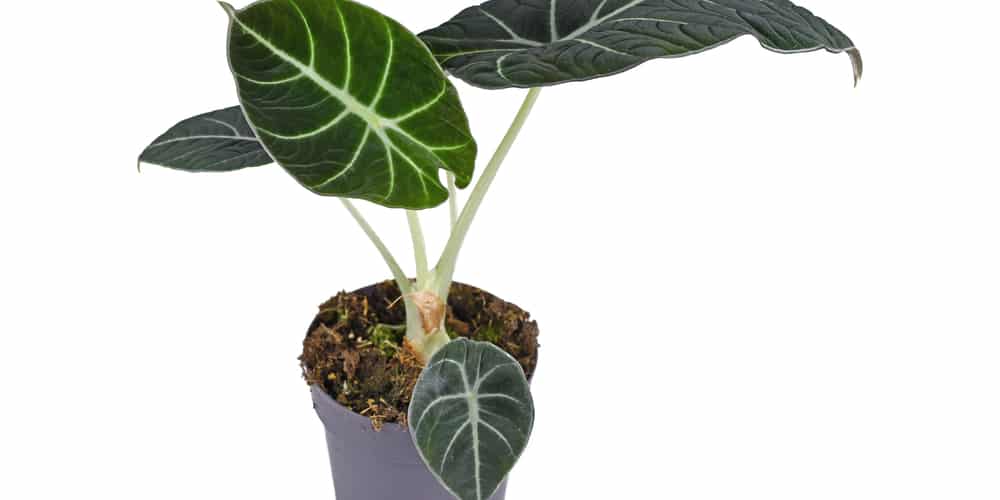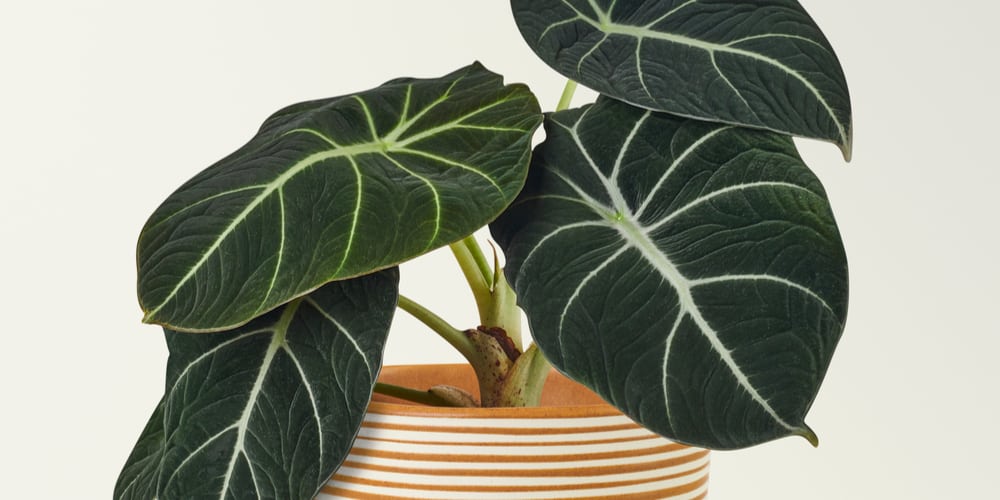If you’re looking for a plant that will add a touch of luxury to your home, look no further than the Alocasia Black Velvet. Also known as the Polly Alocasia or African Mask Plant, this striking plant is sure to turn heads. The Alocasia Black Velvet is native to Southeast Asia and is prized for its dramatic, velvety black leaves.
Alocasia Black Velvet is a slow-growing plant, meaning you can’t expect it to grow or mature overnight or in a week. If it’s properly cared for, expect it to mature into a beautiful plant with gorgeous leaves.
Also, Alocasia Black Velvet is a relatively low-maintenance plant, but it can be susceptible to pests and disease if not properly cared for.
| Botanical Name | Alocasia reginula A.Hay |
| Common Name | Alocasia Black Velvet, Velvet Elephant’s Ear |
| Plant Type | Perennial |
| Flower Color | White |
| Size When Mature | 10 to 15 inches |
| Bloom Time | Occasionally blooms regardless of the season |
| Sun Requirements | Partial Sunlight |
| USDA Hardiness Zones | 10-13 |
| Soil PH Range | 6-7 |
| Soil Type | Acidic or Neutral, Well-Draining |
| Water Needs | Low to Medium |
| Native Area | Southeast Asia |
What You Need to Know About Alocasia Black Velvet
Also known as the “velvet elephant’s ear,” this plant is characterized by its large, glossy leaves adorned with contrasting white veins. This plant is also a slow grower, so don’t expect it to reach its full potential overnight.
The plant usually has a height of 10 inches and can grow up to 15 inches. When planting, be sure to give it plenty of room to spread out, as the leaves can get quite large. This plant is a tropical species that require warm temperatures and high humidity to thrive. When grown indoors, you should place this plant in an east- or north-facing window.
Growing this plant is a slow process but relatively easy as long as you provide proper care. The plant has no fragrance and is poisonous if ingested, so it’s important to keep it out of reach of children and pets.
The plant can bloom with white flowers throughout the entire year, usually lasting for a day, but you don’t get the plant for its flowers. You get it for its dark green, velvet leaves with beautiful white veins running through them. Considering its short bloom time and the fact that the plant is grown for its foliage, the Alocasia Black Velvet is best kept as a houseplant.
How to Care for Alocasia Black Velvet
Here’s everything you need to know about growing and caring for a thriving Alocasia Black Velvet:
Light
When caring for the Alocasia black velvet, light is one of the most important considerations. The plant prefers bright, indirect light and will do best if it receives several hours of sunlight daily. However, it is important to avoid direct sun, as this can scorch the leaves.
If you are unsure whether your plant is getting enough light, you can check the leaves for signs of yellowing or brown patches. These indicate that the plant is not getting enough light and should be moved to a brighter spot.
Water and Soil Needs
When it comes to watering, Alocasia black velvet likes to be kept moist but not soggy. Allow the top inch or so of soil to dry before watering again. If the leaves start to droop, that is a sign that the plant is thirsty and needs more water. Soil that is too wet can lead to root rot, so be sure to drain any excess water from the pot after watering.
As for soil, Alocasia black velvet prefers a rich, well-draining potting mix with a soil PH of acid or neutral. A mix of peat moss, perlite, and vermiculite works well. Be sure to avoid using soil from your garden as it may contain harmful chemicals or pests that could harm the plant.
Ensuring the Alocasia Black Velvet gets the right water and soil needs is crucial to its health.
Temperature Requirements
The Alocasia Black Velvet is hardy in USDA zones 10-13. When caring for this plant, it is vital to provide the plant with the correct temperature conditions. The ideal temperature range for this plant is between 60-86 degrees Fahrenheit. If the temperature gets too hot or too cold, the leaves will start to curl.
To avoid this, place your Alocasia Black Velvet in an area of your home that receives indirect sunlight and has a consistent temperature.
Fertilizer
Alocasia black velvet is a light feeder and does not require much fertilizer. Feeding with a balanced liquid fertilizer during the growing season should be sufficient. Be sure to dilute the fertilizer to half strength to avoid burning the roots.
The best fertilizer to use on an Alocasia Black Velvet is a slow-release fertilizer high in nitrogen. This fertilizer will provide the plant with a steady supply of nutrients and will not burn the roots. Fertilize your Alocasia Black Velvet every two to three months during the spring and summer. Be sure to reduce the frequency of fertilization in the fall and winter when the plant is dormant.
Common Diseases
The plant is susceptible to root rot and should be watered carefully. Common diseases of the Black Velvet Alocasia include leaf spot, Anthracnose, crown rot, and mealybugs.
Leaf spots, Anthracnose, and Crown rot are all caused by different types of fungus. Leaf spots are when the plant is exposed to a particular fungus that attacks the plant leaves and causes small brown spots to form. Anthracnose is when the stems and leaves of the plant are attacked by fungus. Crown rot is when a type of fungus attacks the crown or center of the plant that eventually kills the plant. Mealybugs, on the other hand, are small, white insects that feed on the plant’s sap and can cause the leaves to turn yellow and drop off.
Alocasia Black Velvet Propagation
The Alocasia Black Velvet can be propagated by division or by seed. If you are propagation by seed, it is best to sow the seeds in a peat-based potting mix in the spring. Once the seedlings have emerged, you can transplant them into individual pots filled with a well-drained potting mix.
If you are propagating by division, you will need to divide the rhizome of the plant carefully. Each section of the rhizome should have one or two leaves attached. You can then transplant these divisions into individual pots filled with a well-drained potting mix.
Remember to water the newly transplanted divisions well and to keep them in an area with indirect sunlight and a consistent temperature. Once the plants have settled in, you can start to fertilize them every two to three months.
Related Article: Alocasia Melo


